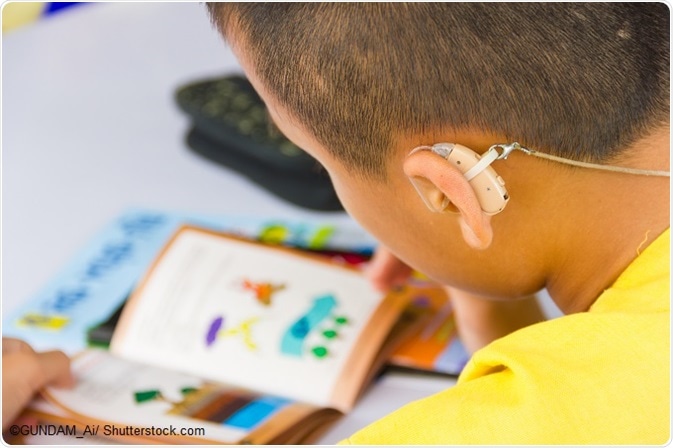Gene mutation, environmental causes such as maternal infections during pregnancy, as well as postnatal complications can cause hearing loss in infants. While genetic causes account for 50–60%, environmental causes account for more than 25% of hearing loss among infants.
In some cases, a combination of genetic elements and outside factors could lead to hearing loss. Some medicines are also known to cause potential hearing loss; however, they mostly affect people with certain gene mutations. When a single person in a family suffers from hearing loss, it is called sporadic, but when it runs in the family, it is called familial.

Genetic causes
There are more than 400 known genetic reasons that could result in hearing loss. The most common forms of genetic hearing loss are due to the dominant and recessive genes of which 15% is from dominant, 70% from recessive, and 15% results from other modes of inheritance. The gene encoding Connexin 26 (CX26) is known to be the main cause for most recessive gene hearing loss. Some individuals with hearing loss are also blind. Syndromic and non-syndromic are two kinds of hearing impairments prevalent at 30% and 70%, respectively.
Syndromic
Depending on the method by which a particular gene is passed from one generation to the other, we further classify syndromic hearing impairment as follows:
- Autosomal dominant
A child has a 50% possibility of inheriting the gene with the dominant mutation if one parent has the condition. The most common type of this syndrome is the Waardenburg syndrome (WS) that is reflected in variable degrees of sensoineural hearing loss and pigmentary aberration of the skin and eyes. Penetrance is high in the Branchiootorenal syndrome (BOR), leading to conductive, sensorineural, or mixed hearing loss. Three types of stickler syndromes are identified that attribute to progressive sensorineural hearing loss. A rare, treatable kind of syndrome is Neurofibromatosis 2 (NF2), in which hearing loss typically begins after 30 years and puts individuals at risk for a variety of tumors.
- Autosomal recessive
Here, a child has a 25% possibility of inheriting the gene with recessive mutation when both parents are carriers of the condition. Usher syndrome—the most common type—results in sensorineural and retinitis pigmentosa (RP). The second most common type, Pendred syndrome, leads to severe-to-profound sensorineural and euthyroid goiter. Patients affected by Jervell and Lange-Nielsen syndrome have syncopal episodes that may lead to unexpected death. Biotinidase deficiency results in sensorineural hearing loss and also develops neurologic and cutaneous features. The extremely rare Refsum disease causes severe progressive sensorineural hearing loss and RP.
- X-linked recessive
This is passed through families via female carriers who do not have the condition; however, each offspring from her has a 50% possibility of getting the condition. In Alport syndrome, until 10 years, hearing loss is not evident; however, it progresses to sensorineural hearing loss of varying severity, and glomerulonephritis, leading to end-stage renal disease. In the Deafness-dystonia-optic neuronopathy (DDON) syndrome, also known as Mohr-Tranebjaerg syndrome, TIMM8A gene mutation is the cause, characterized by sensorineural hearing loss.
- Multifactorial
In the combination of genetic and nongenetic factors, the second child will have a 3–5% chance of the condition when the first child has a multifactorial condition. Infants diagnosed with multifactorial conditions are usually born in families with no other affected family member. Hearing loss associated with age factors such as Presbycusis belong to the multifactorial category.
- Mitochondrial inheritance
In individuals with a mitochondrial disorder, the auditory system is affected in the auditory cortex and cochlea, present in the inner ear, which is the component most sensitive to mitochondrial dysfunction. This condition is passed to the child from the mother if she has a mitochondrial condition.
Approximately 30% of Mitochondrial Encephalopathy, Lactic Acidosis and Stroke-like Episodes (MELAS) – may be characterized by sensorineural hearing loss. Similarly, in Maternally Inherited Diabetes and Deafness (MIDD), Kearns-Sayre Syndrome (KSS), Myoclonic Epilepsy, and Ragged Red Fibers (MERRF) the hearing loss is sensorineural.
Non-syndromic
In autosomal dominant type hearing loss, heterogeneity is high and the hearing loss does not have a particular single gene accountable in the majority of cases. In contrast, in Autosomal Recessive type hearing loss, the variant GJB2 is what causes deafness in 50% of the world’s population. X-linked nonsyndromic hearing loss is characterized by severe prelingual hearing loss that is progressive. The variants in the gene subsets—MT-RNR1,MT-TSI, MT-CO1 are the reasons for maternally inherited – Mitochondrial Nonsyndromic Hearing Impairment. Infants are kept away from using aminoglycosides when the mother has the m.1555A>G pathogenic variant of MT-RNR1, as she may pass it to the child through these antibiotics – they show signs of partial placental transfer.
Genetic Counseling
Physicians can counsel individuals and family members on the mode of inheritance, implications, and possible genetic risks involved; availability of prenatal testing before pregnancy will educate people and assist in decision making.
Sources
- https://www.cdc.gov/ncbddd/hearingloss/genetics.html
- www.cdc.gov/ncbddd/hearingloss/freematerials/parentsguide508.pdf
- ghr.nlm.nih.gov/…/deafness-dystonia-optic-neuronopathy-syndrome
- https://www.ncbi.nlm.nih.gov/books/NBK1434/
- https://www.babyhearing.org/HearingAmplification/Causes/genetics.asp
- https://www.ncbi.nlm.nih.gov/pmc/articles/PMC1867482/
Further Reading
- All Ear Content
- How Does the Ear Work?
- Causes of Hearing Loss
- Causes of Tinnitus
- Earwax – Cerumen
Last Updated: Aug 23, 2018
Source: Read Full Article
